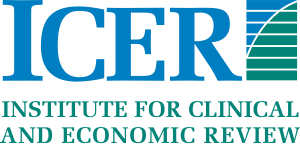— Report notes the significant remaining uncertainty about the long-term safety of CGRP inhibitors given their new mechanism of action, highlights that their clinical and economic value hinges on use among patients for whom other available treatments have not been successful —
Boston – July 3, 2018 – The Institute for Clinical and Economic Review today released a Final Evidence Report and Report-at-a-Glance on three calcitonin gene-related peptide (CGRP) inhibitors for prevention of migraine attacks: erenumab (Aimovig™, Amgen/Novartis), fremanezumab (Teva), and galcanezumab (Eli Lilly). Erenumab was approved in May of 2018, while the other two agents remain under FDA review.
ICER’s report was reviewed at a June 2018 public meeting of the California Technology Assessment Forum (CTAF). Panel members voted that evidence was adequate to demonstrate a net health benefit of the CGRP inhibitors for individuals with chronic migraine and no other available treatment options. While acknowledging the significant impact even infrequent migraine has on day-to-day life, a majority of Panel members pointed to the unknown long-term risks in voting that current evidence is inadequate to show a net health benefit of the CGRP inhibitors for individuals with episodic migraine.
Panel members noted that the therapies may provide potential additional benefits beyond those studied in clinical trials, including reduced family/caregiver burden, a novel mechanism of action that may allow for successful treatment of patients without other options, and increased productivity. Further, the high severity and lifetime burden of illness, along with the significant uncertainty around long-term risks and the magnitude and durability of benefit, were noted as key contextual considerations that factored into CTAF’s assessment of value.
Voting on the long-term value for money of erenumab, the only CGRP drug with a publicly-available price, a majority of the panel voted that erenumab represents an intermediate value in adults with chronic migraine, and votes were split between intermediate and low long-term value for money when the drug is used for patients with episodic migraine.
“Although there is a wide spectrum of disease severity, in some people migraine can have a very large impact on quality of life, and these therapies offer hope to patients who have not seen new treatments in a long time,” noted David Rind, MD, MSc, ICER’s Chief Medical Officer. “At the same time, these therapies work on a novel pathway, and we do not yet have adequate evidence to know if the treatments will be associated with long-term, uncommon side effects. Given this, as well as the high price of these therapies relative to oral preventive treatments and uncertainties around long-term efficacy, it is reasonable for insurers to develop evidence-based prior authorization criteria to ensure prudent use of CGRP inhibitors.”
Policy Implications
Following the voting session during the CTAF meeting, a policy roundtable of experts – including patient advocates, physicians, public and private payers, and drug manufacturers – convened to discuss the implications of the evidence for policy and practice. Key recommendations stemming from the roundtable discussion include:
- When responsible pricing is accomplished and the net price of CGRP inhibitors aligns with the estimated added benefit for patients, prior authorization criteria should be relatively streamlined and allow documentation of eligibility through a clinician statement that patients have attempted adequate trials of two to three other preventive therapies rather than requiring extensive submission of clinical documents.
- Following the example set by the launch of the first CGRP inhibitor, manufacturers should continue to exercise restraint and ensure net prices align reasonably with the added benefits for patients. Consideration of price increases in future years should be transparently justified by new clinical evidence of superior performance.
- Clinicians should be aware of the uncertainties in long-term efficacy and potential harms when prescribing CGRP inhibitors. The FDA has requested additional research into liver toxicity and risks for heart attack and stroke after exposure to erenumab, and into potential adverse effects when erenumab is used during pregnancy.
Additional policy implications, as well as more detailed discussion of the implications, are available in ICER’s Final Report.
About ICER
The Institute for Clinical and Economic Review (ICER) is an independent non-profit research institute that produces reports analyzing the evidence on the effectiveness and value of drugs and other medical services. ICER’s reports include evidence-based calculations of prices for new drugs that accurately reflect the degree of improvement expected in long-term patient outcomes, while also highlighting price levels that might contribute to unaffordable short-term cost growth for the overall health care system.
ICER’s reports incorporate extensive input from all stakeholders and are the subject of public hearings through three core programs: the California Technology Assessment Forum (CTAF), the Midwest Comparative Effectiveness Public Advisory Council (Midwest CEPAC), and the New England Comparative Effectiveness Public Advisory Council (New England CEPAC). These independent panels review ICER’s reports at public meetings to deliberate on the evidence and develop recommendations for how patients, clinicians, insurers, and policymakers can improve the quality and value of health care. For more information about ICER, please visit ICER’s website.
